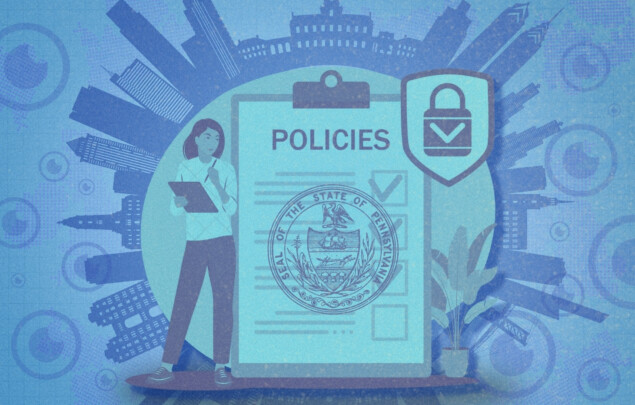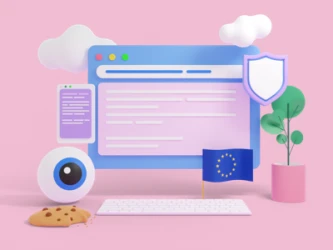A Guide To Pennsylvania’s Consumer Data Privacy Act (PCDPA)
A Guide To Pennsylvania's Consumer Data Privacy Act (PCDPA)

Create a tailored Privacy Policy, Terms & more in under 5 minutes.

Whether you’re a website owner or a website user, understanding Privacy Policies is essential to navigating today’s complicated digital landscape. In this article, we’ll embark on a deep dive into the fundamental elements of crafting a robust website privacy policy and arm you with essential insights for compliance.
1.1 What Is a Privacy Policy?
A Privacy Policy serves as the foundation of trust between a website and its visitors. It’s the document that tells users what happens to their data once it’s collected. Think of it as the terms and conditions for data usage. A Privacy Policy typically includes details about the types of data collected, how it’s used, and how it’s protected.
1.2 Why Is It Important?
Privacy Policies are more than just legal jargon; they’re essential for several reasons. Firstly, they build trust with your audience. Visitors want to know their data is handled responsibly. Secondly, Privacy Policies are often required by law. And lastly, they boost your website’s credibility; a well-crafted Privacy Policy shows you’re committed to transparency and data protection.
1.3 Who Needs a Privacy Policy?
The answer is almost everyone. Privacy Policies are vital for any website or app that collects user data. This includes e-commerce sites, blogs with newsletter sign-ups, social media platforms, and more. Whether your website is big or small, if you collect data, you need a Privacy Policy.
Now that you understand the importance of Privacy Policies let’s dive into their essential components. These elements are the building blocks of a comprehensive and compliant Privacy Policy.
2.1 Information Collection
This section delves into the specifics of data collection. It’s crucial to outline what kind of data you collect and why you need it. If you have contact forms, newsletter sign-ups, or use cookies, it’s essential to explain these processes transparently.
2.2 Cookies and Tracking
Cookies are tiny files that websites place on users’ devices. They serve various purposes, from remembering login credentials to tracking user behavior for analytics. Your Privacy Policy should explain the types of cookies you use and why.
2.3 Data Use and Purpose
Being clear about how you use collected data is crucial. Users want to know why you’re collecting data and how it benefits them. If you personalize content, improve user experience, or send newsletters, explain it here.
2.4 Data Sharing
Your Privacy Policy should disclose if you share data with third parties. Be specific about who these parties are and why you share data with them. This section is vital for transparency.
2.5 User Rights
Users have rights over their data. This includes the right to access, correct, or delete their data. Your Privacy Policy should explain these rights and allow users to exercise them.
2.6 Security Measures
Data security is paramount. Your Privacy Policy should describe the steps you take to safeguard user data. Mention encryption, secure storage, and regular security audits.
Stay tuned for the next part where we delve into the legal aspects of Privacy Policies, including the GDPR, CCPA, and international laws. We’ll also discuss the options for creating a Privacy Policy that suits your website’s unique needs.
In this section, we’ll explore the legal frameworks that govern data protection and privacy, ensuring your online presence aligns with global and regional laws. These data privacy laws include the General Data Protection Regulation (GDPR), the California Consumer Privacy Act (CCPA), and more. Their widespread applicability makes compliance imperative. Check what privacy policy law/s might pertain to you here.
3.1 GDPR: European Data Protection
If your website collects data from European visitors, you must comply with the General Data Protection Regulation (GDPR). This regulation grants users significant control over their data. Your Privacy Policy should explain how you adhere to GDPR requirements, such as obtaining clear consent and offering data access or deletion options.
3.2 CCPA: California Privacy Laws
California’s Consumer Privacy Act (CCPA) sets strict rules for businesses that collect data from California residents. Even if your business isn’t based in California, you may still need to comply if you have Californian users. Your Privacy Policy should detail how you address CCPA requirements, like providing opt-out options and disclosing data-sharing practices.
3.3 International Laws
Privacy laws vary worldwide. If your website serves a global audience, your Privacy Policy should outline how you meet various international legal requirements, ensuring that users from different regions understand their data rights and how their data is processed.
Now that you have learned the essentials of Privacy Policies and legal compliance, it’s time to craft your own. In this section, we’ll explore different approaches, from custom policies to templates and generators, to help you choose the best fit for your website’s complexity and budget.
4.1 Custom vs. Template
Deciding between a custom Privacy Policy and using a template depends on your website’s complexity and budget. Custom policies provide tailored solutions but are costlier and time-consuming. Templates offer a more affordable and quicker option, but you’ll need to adapt them to your specific needs.
4.2 Privacy Policy Generators
Privacy Policy generators simplify the process. They generate a basic policy based on your input. While not as personalized as a custom policy, generators offer an efficient and legally compliant solution, ideal for small to medium-sized websites. Employing and utilizing a privacy policy generator like GetTerms to create a compliant policy tailored to your business.
Having a well-crafted Privacy Policy is essential, but ensuring users can easily access and review it is equally crucial. This section explores strategies for making your Privacy Policy readily available, especially in the context of mobile apps.
5.1 Accessibility
Your Privacy Policy should be easily accessible. Include links in your website’s footer, on registration pages, and at points where data is collected. Accessibility ensures that users can review your policy whenever they interact with your website.
5.2 Mobile Apps
If you have a mobile app, your Privacy Policy should also be accessible within the app. Users should find it in the app’s settings or through a clearly labeled link. App stores often require this for approval.
Compliance with privacy regulations doesn’t end with the creation and display of your Privacy Policy. In this section, we’ll delve into the ongoing efforts required to maintain compliance and ensure user trust.
6.1 User Consent
To ensure compliance, implement consent mechanisms like checkboxes or pop-ups. Users should actively agree to your Privacy Policy before using your services. This clickwrap method ensures clear consent.
6.2 Regular Updates
Data privacy laws evolve, and your practices may change. Update your Privacy Policy accordingly. Notify users of changes, and provide the revised policy’s effective date. Regular updates demonstrate your commitment to data protection.
Staying informed and equipped is essential for maintaining compliance and user trust. In this final section, we’ll explore additional resources and tools to aid in your ongoing privacy efforts.
7.1 Privacy Tools
Explore online tools and resources to help you create, manage, and stay updated on your Privacy Policy. Consider using cookie consent management platforms, which can simplify compliance with cookie-related regulations.
7.2 Legal Advice
For complex legal matters or if you need clarification on compliance, consult with a legal professional. They can provide guidance tailored to your specific circumstances, ensuring full legal compliance.
Navigating the world of website Privacy Policies may seem daunting, but it’s a crucial step in establishing trust with your users and complying with the law. By understanding the components, legal requirements, and tools available, you can create a Privacy Policy that respects user data and helps your website thrive in the digital age. Remember, transparency and compliance are key to building lasting relationships with your audience as well as protecting your business from legal risks.
Crafting and regularly updating your privacy policy isn’t just wise; it’s a crucial element of your online presence, preventing conflicts with national laws, social media platform rules, and other critical factors. Begin your journey today – Create your personalized Privacy Policy in under 5 minutes with GetTerms.